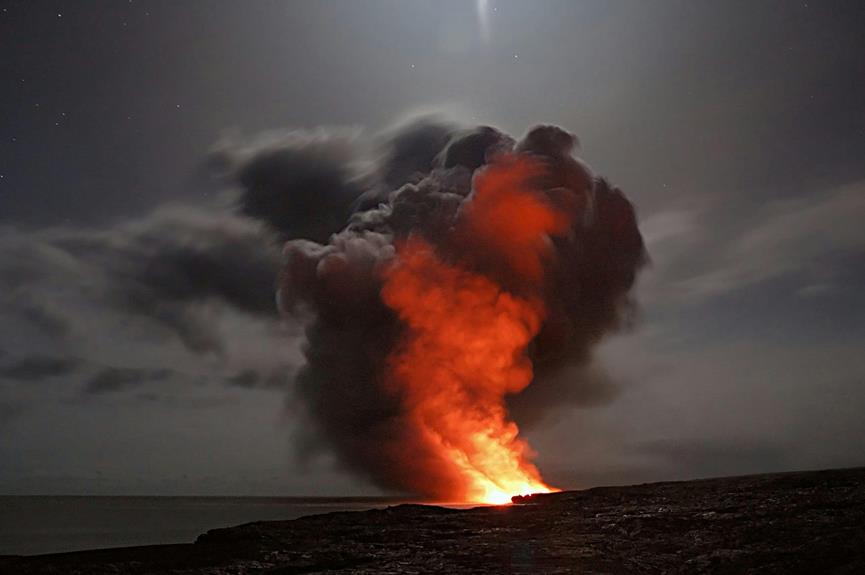The Chernobyl Exclusion Zone in Ukraine stands as a silent witness to one of the most catastrophic nuclear disasters in history. Enveloped in a shroud of mystery and danger, this restricted area raises questions about the long-lasting impact of human intervention on the environment and the resilience of nature in the face of adversity. As we explore the eerie remnants of a once-thriving community, we begin to uncover not only the physical scars left behind by the disaster but also the untold stories of those directly affected. In this zone of exclusion, a delicate balance between preservation and progress emerges, leaving us to ponder the complexities of our relationship with the world around us.
Key Takeaways
- Established after the 1986 disaster
- Strict regulations and boundaries for safety
- Wildlife and ecosystem recovery efforts ongoing
- Abandoned buildings and urban decay present
- Eco-friendly infrastructure projects and sustainable initiatives in progress
Chernobyl Nuclear Disaster: A Brief Overview
Causing catastrophic consequences on April 26, 1986, the Chernobyl Nuclear Disaster remains one of the most significant nuclear accidents in history. The impact of the disaster was far-reaching, with immediate and long-term consequences that affected not only Ukraine but also neighboring countries and the global community. The explosion of Reactor 4 at the Chernobyl Nuclear Power Plant released a massive amount of radioactive material into the atmosphere, contaminating the surrounding area and leading to the evacuation and resettlement of over 300,000 people.
The consequences of the Chernobyl disaster were severe and multifaceted. The immediate effects included the loss of lives, both among plant workers and first responders, and the radioactive fallout spread over large areas, causing acute radiation sickness in many individuals. The long-term consequences were equally devastating, as the radioactive contamination persisted in the environment, leading to an increased incidence of cancer, particularly thyroid cancer, and other health problems among the exposed population.
Furthermore, the economic impact of the Chernobyl disaster was significant, with the cost of the cleanup and containment efforts stretching into billions of dollars. The global nuclear industry also faced increased scrutiny and regulation in the aftermath of the disaster, leading to changes in safety protocols and a reevaluation of the risks associated with nuclear power generation.
Establishment of the Exclusion Zone
The establishment of the Exclusion Zone surrounding the Chernobyl Nuclear Power Plant was a vital measure implemented to restrict access to the highly contaminated area. The boundaries of the Exclusion Zone were carefully demarcated to encompass the most heavily affected regions by radioactive fallout following the catastrophic explosion at the plant in 1986. This exclusion area serves as a buffer zone to minimize human exposure to dangerous levels of radiation and to prevent the spread of contamination beyond its borders.
Radiation protection within the Exclusion Zone is a paramount concern. Strict regulations are enforced to limit entry into the area, with access typically restricted to authorized personnel conducting essential tasks such as maintenance and monitoring. Monitoring stations are strategically positioned to continuously assess radiation levels and ensure that safety standards are upheld. Additionally, protective gear and protocols are mandatory for those entering the zone to minimize the risk of exposure.
Efforts to maintain the integrity of the exclusion zone boundaries are ongoing, with periodic reassessments conducted to adjust the perimeter based on radiation levels and environmental factors. The establishment of the Exclusion Zone remains an essential element in the management of the Chernobyl disaster aftermath, safeguarding both human health and the surrounding environment from the lingering effects of the nuclear catastrophe.
Wildlife and Ecosystem Recovery
Following the Chernobyl disaster, significant efforts have been made to monitor and facilitate the recovery of wildlife and ecosystems within the Exclusion Zone. The region's wildlife has shown remarkable resilience, with many species adapting to the absence of human activity. Wildlife rehabilitation programs have been vital in supporting the recovery process, focusing on species such as Przewalski's horses, European bison, and wolves.
Despite the initial devastation caused by the nuclear accident, the Exclusion Zone has become an inadvertent haven for various animal populations. Studies have shown that the absence of human disturbance has led to an increase in biodiversity, with thriving populations of rare and endangered species. Monitoring efforts have indicated a gradual rebound in wildlife numbers, demonstrating the ecosystem's ability to recover in the absence of direct human interference.
Ecosystem resilience within the Exclusion Zone has been a subject of extensive research, highlighting nature's capacity to rebound from catastrophic events. The reestablishment of balanced food chains and the gradual remediation of contaminated areas have played a significant role in supporting the recovery of the region's ecosystems. These findings underscore the importance of understanding the long-term impacts of environmental disasters on wildlife and the potential for natural habitats to recover when given the opportunity.
Urban Decay and Abandoned Buildings
Notable for its desolate landscapes and deteriorating structures, the Chernobyl Exclusion Zone exhibits a stark portrayal of urban decay and abandoned buildings. The remnants of human habitation within the zone stand as haunting reminders of the tragic events that unfolded in 1986. Urban exploration and photography have become popular activities for those seeking to capture the eerie beauty of these decaying structures frozen in time.
Within the exclusion zone, a variety of buildings, such as schools, homes, and hospitals, lay in various states of disrepair. The peeling paint, crumbling walls, and overgrown vegetation contribute to the sense of desolation that permeates the area. Despite the decay, these buildings hold historical significance, serving as poignant symbols of the human impact of the Chernobyl disaster.
Efforts towards historical preservation and restoration have been sporadic within the zone. Some structures have undergone stabilization to prevent further deterioration, while others remain untouched, succumbing to the forces of nature. The delicate balance between preserving the authenticity of the site and preventing safety hazards poses a challenge for authorities and conservationists.
In the face of urban decay, the abandoned buildings of the Chernobyl Exclusion Zone continue to fascinate and intrigue visitors, offering a glimpse into a world frozen in time by tragedy and human absence.
Tourist Visits and Regulations
Given the increasing interest in the Chernobyl Exclusion Zone, regulations regarding tourist visits have become a focal point for ensuring safety and preservation of the site. Safety precautions are paramount due to the lingering radiation levels in certain areas. Tourists are required to adhere to strict guidelines, including wearing appropriate protective gear such as long-sleeved clothing, closed shoes, and in some cases, respiratory masks to minimize exposure to radioactive particles. Additionally, designated pathways are marked to guarantee visitors stay within safe zones and avoid hazardous areas.
Tourist impact is carefully monitored to prevent damage to the delicate ecosystem that has flourished in the absence of human interference. Visitor numbers are controlled to reduce the strain on the environment and prevent excessive disturbance to wildlife. Moreover, strict rules are in place to deter vandalism and looting of artifacts in abandoned buildings, preserving the historical significance of the site.
Authorities continuously assess and update regulations based on environmental studies and safety assessments to strike a balance between allowing visitors to experience the unique history of Chernobyl while safeguarding both their well-being and the integrity of the exclusion zone. By implementing these measures, the Chernobyl Exclusion Zone can be enjoyed responsibly and sustainably for years to come.
Future of the Chernobyl Exclusion Zone
The future trajectory of the Chernobyl Exclusion Zone hinges on strategic planning to balance preservation efforts with sustainable development initiatives. Ensuring future sustainability while capitalizing on economic opportunities within the Zone is essential for its long-term viability.
To achieve future sustainability, it is imperative to strike a delicate balance between preserving the environmental integrity of the Zone and harnessing its potential for economic growth. Implementing eco-friendly infrastructure projects, such as renewable energy installations or sustainable agriculture initiatives, can help minimize the environmental impact while creating job opportunities and promoting economic growth within the Zone.
Moreover, exploring eco-tourism as a means to generate revenue can be a viable option for the future of the Chernobyl Exclusion Zone. By offering guided tours that focus on the Zone's history, environmental significance, and ongoing recovery efforts, visitors can gain insight into the consequences of nuclear disasters while contributing to the local economy.
Investing in research and innovation within the Zone can also pave the way for future sustainability. Collaborating with scientific institutions to study the long-term effects of the Chernobyl disaster and develop innovative solutions for environmental remediation can not only benefit the Zone but also contribute to global knowledge on nuclear safety and disaster management.
Frequently Asked Questions
Can People Still Live in the Chernobyl Exclusion Zone?
Living in an area with high radiation levels poses severe health risks due to potential exposure.
The effects of radiation on human health can lead to various complications, including an increased risk of cancer and other serious illnesses.
Consequently, residing in zones with elevated radiation levels, such as the Chernobyl Exclusion Zone, is not advisable as it can have detrimental consequences on individuals' well-being and overall health.
What Measures Are in Place to Prevent Looting in the Abandoned Buildings?
To prevent looting in abandoned buildings, various measures can be implemented. Surveillance drones can be utilized to monitor the area and provide real-time footage for security personnel.
Security checkpoints can also be established at key entry points to regulate access and deter unauthorized individuals. These measures help maintain the integrity of the site and protect any remaining valuable assets or artifacts within the buildings.
Are There Any Unique Species of Wildlife That Have Thrived in the Zone?
Unique species of wildlife have thrived in the area due to the absence of human interference. This phenomenon highlights the potential for wildlife conservation in such environments.
The presence of these species underscores the importance of protecting natural habitats and fostering biodiversity. Understanding the dynamics of these unique ecosystems can provide valuable insights into the resilience of wildlife populations when left undisturbed.
Conservation efforts in such areas can offer opportunities for studying and safeguarding these species.
How Are Tourists Educated About the Safety Risks Before Visiting?
Tourists are informed about safety risks through thorough safety protocols that outline potential hazards and necessary precautions. Before visiting, detailed information on emergency procedures is provided to guarantee visitor awareness and preparedness.
This includes briefings on radiation exposure, protective gear requirements, restricted areas, and adherence to guidelines. By emphasizing safety measures, tourists can make informed decisions and mitigate potential risks while exploring sensitive environments.
What Innovations Are Being Explored for Sustainable Development in the Future?
In the domain of sustainable development, groundbreaking innovations are being explored to propel progress.
From harnessing renewable energy sources to implementing cutting-edge green technology, the landscape is evolving with promise.
The fusion of creativity and technology is paving the way for a more environmentally conscious future.
These endeavors are not merely aspirations but rather tangible initiatives driving towards a future where sustainability is at the forefront of progress.
Conclusion
In summary, the Chernobyl Exclusion Zone serves as a cautionary tale of the enduring consequences of nuclear disasters. Like a scar on the earth, it stands as a reminder of the importance of responsible nuclear energy practices.
The ongoing efforts to monitor wildlife recovery and implement sustainable practices within the Zone are vital in ensuring its long-term integrity and sustainability.
The future of the Chernobyl Exclusion Zone hinges on continued vigilance and commitment to environmental stewardship.


